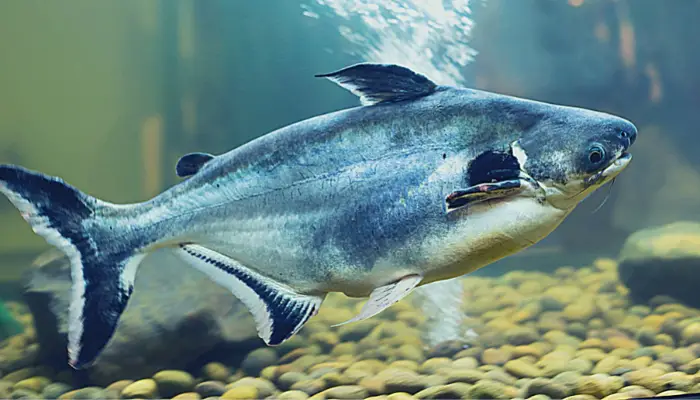If you’ve ever wondered about the unique characteristics of catfish, you’re not alone! These fascinating aquatic creatures have captivated anglers, aquarium enthusiasts, and curious minds alike. One question that often arises is: do catfish have scales or skin?
The answer might surprise you and reveal a lot about their incredible adaptations. Whether you’re a fish enthusiast or just curious about nature’s wonders, understanding the anatomy of catfish offers a glimpse into their survival tactics in various aquatic environments.
Catfish do not have scales on their bodies. Instead, they are typically “naked,” with smooth skin that serves a vital purpose.
In many species, this skin is covered in a protective mucus layer, which helps reduce friction while swimming, guards against infections, and enhances their ability to detect changes in their surroundings.

This unique feature sets them apart from many other fish species and is one of the reasons they thrive in diverse aquatic habitats.
Keep reading to dive deeper into the intriguing world of catfish, explore their adaptations, and discover what makes them so remarkable!
Table of Contents
ToggleDo Catfish Have Scales and Fins?
Unlike many other fish species, catfish don’t have traditional scales. Instead, they possess a smooth skin that is often covered with bony plates, a unique adaptation that helps protect them in their aquatic environment.
The fins of catfish are well-formed, allowing them to navigate through freshwater and coastal waters effectively, showcasing the dexterity of these fascinating fish.

Most catfish species, including the channel catfish and blue catfish, have a distinctive appearance characterized by their whisker-like barbels. These barbels aid in sensing their environment, especially in murky waters.
While catfish have fins that resemble those of other fish, their lack of scales sets them apart, making them a unique group within the ray-finned fish family.
What are the Characteristics of Catfish?
Catfish are known for their diverse species, which vary significantly in size and shape. The largest member, the Mekong giant catfish, can grow up to 10 feet long, whereas smaller species, like the channel catfish, are often found in local waters.
Their bodies are typically elongated, and they have a flattened head, which contributes to their unique profile.
In addition to their physical attributes, catfish possess specialized sensory organs that enhance their ability to detect food and navigate their surroundings.
The barbels on their face are particularly sensitive, allowing them to feel vibrations and chemical changes in the water. This sensory adaptation is crucial for survival, as it helps them hunt in both freshwater and coastal environments.
Are Catfish Considered Kosher?
When it comes to dietary laws, the classification of catfish can be quite complex. Traditional kosher guidelines state that fish must have both fins and scales to be deemed kosher.
Since catfish don’t have scales, they are generally not considered kosher by Jewish dietary standards. This distinction is vital for those who observe kosher practices.
However, due to the popularity of farm-raised catfish, some people may question these classifications. The farming practices of catfish have evolved, leading to an increase in their consumption.
Despite this, it’s essential to adhere to traditional interpretations when it comes to dietary restrictions, understanding that not all fish that live in water meet kosher requirements.
What are the Habitats of Catfish?
Catfish are incredibly adaptable and can be found in various aquatic environments. They inhabit freshwater bodies, including rivers, lakes, and ponds, across every continent except Antarctica. Coastal waters also provide a suitable habitat for some species of catfish, allowing them to thrive in diverse ecosystems.
In the United States, states such as Texas and Arkansas are known for their abundant populations of farm-raised catfish.
These fish are cultivated in controlled environments, contributing to the local economy. Additionally, wild catfish species, like the flathead catfish and wels catfish, roam freely in various habitats, showcasing their adaptability to different water conditions.
What are Common Misconceptions About Catfish?
There are several misconceptions about catfish that stem from their unique characteristics. One common belief is that all catfish are bottom feeders.
While many species do scavenge on the riverbed, some, like the African catfish, actively hunt for prey. This misunderstanding can lead to a negative perception of catfish as unclean or undesirable fish.
Another misconception is that catfish are all venomous. While certain species possess venomous spines, not all catfish are harmful to humans. Understanding the diversity among the different species of catfish is crucial to dispelling these myths and appreciating their ecological roles in freshwater and coastal habitats.
Can I Add a Cat fish to My Aquarium?
Adding a catfish to your aquarium can be a great idea, as they are often peaceful and helpful in keeping the tank clean. However, there are some considerations to keep in mind before adding a catfish to your aquarium:
- Tank Size: Make sure your aquarium is large enough to accommodate the specific type of catfish you are considering. Different species have different space requirements.
- Compatibility: Check if the catfish you want to add is compatible with the other fish in your aquarium. Some catfish can be territorial or aggressive towards certain species.
- Water Parameters: Catfish have specific water parameter requirements, such as pH levels, temperature, and water hardness. Ensure that these parameters match the needs of the catfish you want to add.
- Diet: Catfish have varied diets, so make sure you can provide the appropriate food for the specific species you choose.
- Hiding Places: Catfish are often nocturnal and like to have hiding spots in the aquarium. Provide caves or plants where they can retreat to during the day.
- Research: Before adding any fish to your aquarium, always do thorough research on the specific species you are interested in to understand their care requirements.
If you have considered these factors and believe that a catfish would be a good addition to your aquarium, go ahead and introduce one, ensuring that you provide a suitable environment for its well-being.
FAQs
Does catfish have scales or skin?
Catfish are generally known for having skin rather than scales. Unlike many fish that have scales, catfish belong to the group of ray-finned fish and are characterized by their smooth, sometimes slimy skin.
What types of catfish species live in freshwater?
The majority of cat fish species live in freshwater environments. They inhabit shallow waters like rivers, lakes, and ponds, making them a common sight in many freshwater ecosystems.
Are catfish caught for food?
Yes, catfish are considered food fish and are popular in various cuisines. Farm-raised catfish are grown specifically for consumption and are widely available in markets.
What is the significance of the whisker-like barbels on catfish?
Catfish have barbels, which are whisker-like appendages that help them sense their environment. These barbels contain chemoreceptors that allow catfish to detect food and navigate through murky waters.
Can you find catfish in coastal waters?
While catfish are primarily freshwater fish, some species can also inhabit coastal waters of every continent, showcasing their adaptability to different environments.
What are some common species of catfish in the United States?
In the United States, common catfish species include the channel catfish and the flathead catfish. These species can be found in various freshwater habitats across the states.
Are catfish considered kosher fish?
Catfish are generally not considered kosher fish because they do not have scales. In kosher dietary laws, fish that have scales are required to be considered kosher, and since catfish have skin instead, they do not meet this criterion.
How do catfish compare in size and shape?
A: Catfish come in different shapes and sizes, ranging from small species to large ones like the Mekong giant catfish. This diversity is one of the fascinating aspects of the siluriformes order, to which catfish belong.
What are the dorsal and pectoral fins used for in catfish?
Catfish have dorsal and pectoral fins that play crucial roles in their mobility and stability in water. These fins help them maneuver through their aquatic habitats and can also be used defensively.
Are there any related videos or resources to learn more about catfish?
Yes, there are many related videos and resources available online that delve deeper into the biology and ecology of catfish. These can provide visual insights into their behavior, habitat, and characteristics.
Does catfish have fins and scales?
Do catfish have fins and scales? Yes, catfish have fins, but they lack scales. 1 Their bodies are typically covered in a thick layer of slime instead.
Why do catfish have no scales?
Catfish lack scales because they have evolved a different form of protection. Their bodies are covered in a thick layer of slime that helps to protect them from predators and parasites. In addition, some catfish have bony plates embedded in their skin that provide additional protection.
Conclusion
So, Do Catfish Have Scales? In conclusion, catfish are a diverse group of fish that exhibit unique characteristics, including the absence of traditional scales. They inhabit a wide range of environments and are often misunderstood due to common misconceptions. By exploring the anatomy and habitats of catfish, we gain a deeper appreciation for these fascinating creatures and their contributions to aquatic ecosystems.
Related articles
- Green Cory Catfish: Ultimate Care Guide, Tank Mates & More!
- Corydoras Panda 101: Unlock the Secrets of Cory Panda Fish!
- How to Tell If Corydoras Are Happy & why it matters?
- Spotted Raphael Catfish: Diet, Tank Mates, Diseases & (More)
- Cory Catfish 101 – Types, Diet, Lifespan & Tankmates (FAQ)
- How Long Do Catfish Live: a Comprehensive Beginners Guide
- Corydoras Pantanalensis C5: Price, Care, Breeding & More!




